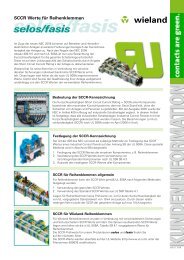safety - Catalogue (0860.1) - Wieland Electric
safety - Catalogue (0860.1) - Wieland Electric
safety - Catalogue (0860.1) - Wieland Electric
You also want an ePaper? Increase the reach of your titles
YUMPU automatically turns print PDFs into web optimized ePapers that Google loves.
S4000<br />
Basic device with time function – SNV 4063KL<br />
Applications<br />
• Protection of people and machinery<br />
• Monitoring of emergency stop applications<br />
• Monitoring of <strong>safety</strong> gates<br />
• Termination of braking operations through OFF-delay time<br />
• Control of solenoid-actuated interlocks<br />
• Up to PL e / Category 4 (EN ISO 13849-1)<br />
• Up to SIL CL 3 (EN 62061)<br />
Features<br />
• Stop category 0/1 according to EN 60204-1<br />
• Single-channel or two-channel control<br />
• Manual or automatic start<br />
• OFF-delay time adjustable in the<br />
range 0.15 to 3 s or 1.5 to 30 s<br />
• Reset button monitoring, cross monitoring,<br />
monitoring of synchronous time<br />
• 3 enabling current paths (2 undelayed, 1 OFF-delayed)<br />
Function<br />
With the supply voltage applied to terminals A1/A2 and the emergency set right<br />
and left margins in-line button. This controls relays K1 to K4, which become selflocking<br />
(when starting via reset button monitoring after the response time). After<br />
this switch-on phase the 3 enabling current paths are closed (terminals 13/14,<br />
23/24 and 37/38).<br />
Three LEDs display the state of relays K1/K2, K3/K4 and the supply voltage.<br />
If the emergency stop button is activated, the current supplies for relays K1 to K4<br />
are interrupted. The undelayed enabling current paths (terminals 13/14, 23/24)<br />
are opened with release time tR 1 while the off-delayed enabling current path<br />
(terminals 37/38) is opened after the pre-set OFF-delay time t R2. The OFF-delay<br />
time can be adjusted infinitely in the range 0.15 to 3 s or 1.5 to 30 s. With a<br />
two-channel control and cross-monitoring wiring of the sensor circuit, additional<br />
errors such as short-circuit or ground fault can be detected. An electronic<br />
fuse protects the device against damage. After the cause of the malfunction<br />
has been removed, the device is operational again after approx. 3 s.<br />
• Reset button monitoring – The device can be started either with the falling<br />
edge or with the rising edge (terminals S34 or S35). For emergency stop applications<br />
with manual start the button must be connected to terminals S33/S34.<br />
The device is enabled only with the falling edge of the reset signal. For starting,<br />
the reset button must be pressed and released. For <strong>safety</strong> gate applications in<br />
which an automatic start is performed it is necessary to bridge terminals S33/<br />
S35. The device will react at the rising edge of input S12 which is internally<br />
connected to S33.<br />
• Monitoring of synchronous time – The use of <strong>safety</strong> limit switches for<br />
single-channel or two-channel circuits in <strong>safety</strong> gate applications depends on<br />
the required <strong>safety</strong> level. The device provides a monitoring of the synchronous<br />
time of two connected <strong>safety</strong> switches. A synchronous time t S ≈ 0.5 s requires<br />
limit switches positioned in such a way that channel 1, terminals S11/S12,<br />
closes before channel 2, terminals S21/S22. If channel 2 closes before<br />
channel 1, the synchronous time is t S = ∞.<br />
Circuit diagram<br />
SNV 4063KL<br />
60

















